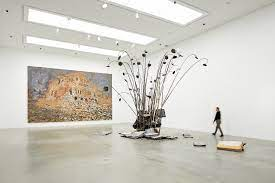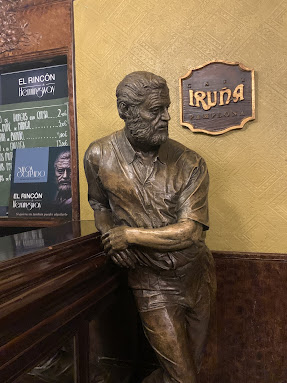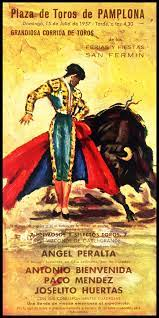Karl Benz with his sells assistant Joseph bretch in the Benz Painted motor car autoan (1886) Andy Warhol.
Welcome to all. If you are attending André Malraux high school in Biarritz, this is your blog. Feel free to express yourself in English, Spanish, German (or in any other language except French) in this blog. Just send your article to one of your teachers so as to be able to contribute to this blog. Everyone is welcome to do so. The language teachers.
Monday, 16 May 2022
Favorite piece of the Gugenheim
Sunday, 15 May 2022
FAVORITE PIECE OF THE GUGGENHEIM
Located in Bilbao, the Guggenheim museum is full of masterpieces. Our favorite one is "Die berühmten Orden der Nacht" (The Renowned Orders of the Night) by Anselm Kiefer.
 |
| The Renowned Orders of the Night |
The canvas represent a man laying down on the ground. Over him, the sky takes 3/4 of the painting. The sky is black and full of white stars that are glowing in the dark. The canva is massive ( more than 3m) in order to make the experience even more realistic. We can say that it is a sort of self-portrait because the man on the ground is him.
 |
| Anselm Kiefer |
 |
| A contemporary artist |
 |
| Kiefer's art in Barjac, France |
His philosophy is that art consists of using is spirituality and refelxions in order to find the meaning of life. He also likes to represent the "incomprehensible and non-representational". During his life, he has been controversial due to his action such as making nazi salutes in various places to show how much the nazi ideology was still there. Now, he lives in the south east of France, in Barjac, and he also often moves to Paris.
Friday, 13 May 2022
Hemingway
Hemingway
Hemingway in Pamplona
This is a picture of the inside of the famous Iruña cafe where Hemingway used to go when he traveled to Pamplona.
HEMINGWAY IN PAMPLONA :
Hemingway is an author that frequently uses travel in his books. Here, in "The Sun Also Rises", he describes his journey in the spanish city of Pamplona. We can see his influence in many places :
His statue is in front of the world famous Pamplona's bullfight area. Everyone can admire the great author before entering in the scene to watch bullfights or the end of the "encierro", a local fiesta that usually happens during summer.
The café Iruna, on the "Plaza del Castillo" is full of Hemingway's aura : an entiere room is dedicated to his memory with photographies and a big statue of the author. Even when you are inside the café, you are able to feel what Hemingway was feeling during is journey in Pamplona.
The corrida is a topic that Hemingway loves to use to illustrate the culture of Pamplona. He describes the torreros, those mens who goes in the scene to fight with the bulls. He also depict the release of the bulls, the first day of the encierro. All the ambient of the fiesta is relevant in Hemingway's work.
Friday, 6 May 2022
Hemingway in Pampelona
A narrow street near the cathedral of Pampelune. The medieval mood that come from this street bring us back in the time where even Hemingway wasn't here there was a city before and after his journey.
 Hemigway have lot's of statue of himself that's show how much he's loved and appreciated by the inhabitants
Hemigway have lot's of statue of himself that's show how much he's loved and appreciated by the inhabitantsThursday, 5 May 2022
The release of the bulls
Day 1
"the marble-topped tables and the white wickers chairs were gone. They were replaced by cast-iron tables and severe folding chairs"
Hôtel Montoya/ Perla
« We got into Pamplona late in the afternoon and the bus stopped in front of the hôtel Montoya »
« We went into the hotel and on the stairs I meet Montoya. He shook hands with us, smiling in his embarrassed way. »
« Aficion means passion. An aficionado is one who is passionate about the bullfights. All the good bullfighters stayed at Montoya's hotel; that is, those with aficion stayed there. The commercial bullfighters stayed once, perhaps, and then did not come back. »
Hotel Perla
The bullfight
“They had hitched the mules to the dead bull and then the whips cracked , the men ran , and the mules , straining toward , their legs pushing , breaking to a gallop , and the bull , one horn up , his head on his side , swept a swath smoothly across the sand and out the ref gate” was
Café Iruña
Café Iruña
The Café Iruña in the Plaza del Castillo was established in 2 July 1888. The Café Iruña has gone down in the history of universal literature as the meeting point for the main characters of ‘The Sun Also Rises/ Fiesta’ the novel that made Hemingway stand out as one of the great writers of all time and that put Pamplona in the map of world literature.
« During the morning I usually sat in the cafe and read the Madrid papers and then walked in the town or out into the country. »
By Beatrice, Eviane, Léa, Joa
Once it s all over
"We came over the mountains and out of Spain and down the white roads."
Léa B
Louann
Solène
Kylian ( guest)
Marthe







































